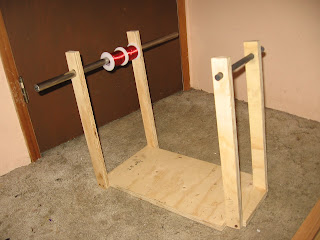Cascadia Hydrogen
Saturday, May 21, 2011
Monday, November 22, 2010
Bifilar Coil
Friday, November 12, 2010
LENR Voltage Jump
The flash of white light is accompanied by a jump in voltage, as measured between the Cathode and Anode. Normal operating voltage is ~300 vdc. During the bright flash, voltage climbed to ~2000 vdc.
I hypothesize that when the plasma completely envelops the Cathode, this is when the flash happens. How or why it happens, I don't know.
Sunday, November 7, 2010
Thursday, November 4, 2010
Monday, October 25, 2010
Spark Gaps can be Negative Resistors
HV Spark Gap Experiments
It's so weird. I was imagining building a device like this for the last couple of days, and then I find someone has already done it! In my imagination, I was thinking of using a Hydrogen Spark Gap, which is a glass tube full of Hydrogen. Here, to make the spark gap, he's using a rod of Carbon and a rod of Thoriated Tungsten (which is a TIG welding electrode, available at your local welding shop). For the Carbon rod I suppose you could use pencil graphite.
Note he is also using Leyden Jars for the capacitors. One interesting property of Leyden Jars is that they generate a radial electric field. They consist of two concentric pieces of metal -- that is, one inside the other along an axis. Imagine a small diameter pipe, and a slightly larger diameter pipe. You can slide the small pipe inside the large one. Now, if you stick little bits of plastic in the ends to keep them from touching, you now have a capacitor whose electric field will be radial. Harold Aspden says that a radial electric field causes ether to spin. There is a way to capture this aether spin energy in a simple oscillator. He gives drawings and a description here: Chapter 11. Compare Apsden's device to the spark gap one above. It seems to me that they are very similar, except one uses a spark gap and the other does not.
I guess another way of making a Hydrogen Spark Gap is to have a (Thoriated?) Tungsten spark gap across the tip of a welding torch, which has Hydrogen spraying out of it. This is exactly what they have in old Atomic Hydrogen welding torches (see post below).
I hypothesize that you could use the spark gap in an Atomic Hydrogen Welding getup as a negative resistance component in an oscillator. An oscillator with negative resistance should keep ringing forever.
It's so weird. I was imagining building a device like this for the last couple of days, and then I find someone has already done it! In my imagination, I was thinking of using a Hydrogen Spark Gap, which is a glass tube full of Hydrogen. Here, to make the spark gap, he's using a rod of Carbon and a rod of Thoriated Tungsten (which is a TIG welding electrode, available at your local welding shop). For the Carbon rod I suppose you could use pencil graphite.
Note he is also using Leyden Jars for the capacitors. One interesting property of Leyden Jars is that they generate a radial electric field. They consist of two concentric pieces of metal -- that is, one inside the other along an axis. Imagine a small diameter pipe, and a slightly larger diameter pipe. You can slide the small pipe inside the large one. Now, if you stick little bits of plastic in the ends to keep them from touching, you now have a capacitor whose electric field will be radial. Harold Aspden says that a radial electric field causes ether to spin. There is a way to capture this aether spin energy in a simple oscillator. He gives drawings and a description here: Chapter 11. Compare Apsden's device to the spark gap one above. It seems to me that they are very similar, except one uses a spark gap and the other does not.
I guess another way of making a Hydrogen Spark Gap is to have a (Thoriated?) Tungsten spark gap across the tip of a welding torch, which has Hydrogen spraying out of it. This is exactly what they have in old Atomic Hydrogen welding torches (see post below).
I hypothesize that you could use the spark gap in an Atomic Hydrogen Welding getup as a negative resistance component in an oscillator. An oscillator with negative resistance should keep ringing forever.
Subscribe to:
Comments (Atom)

